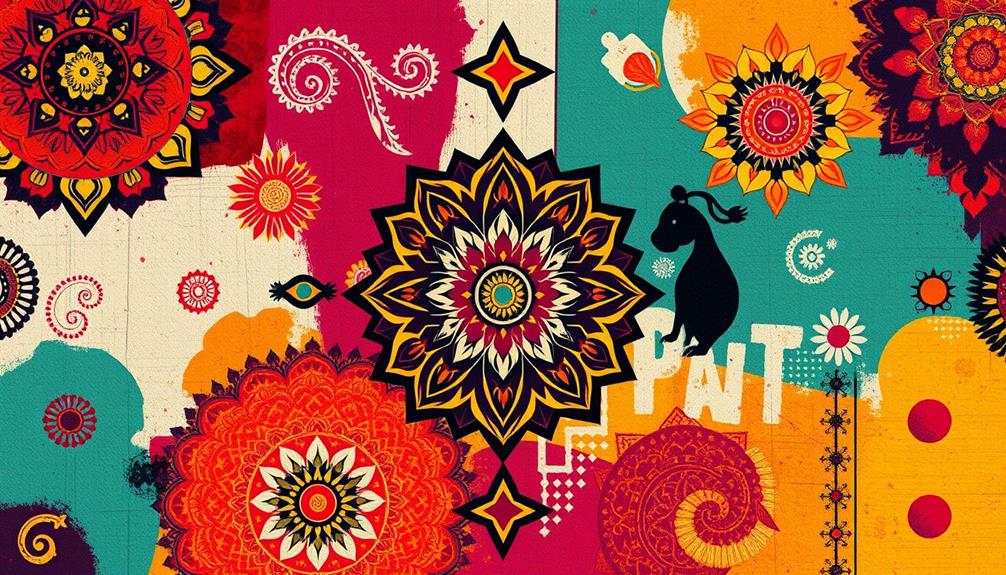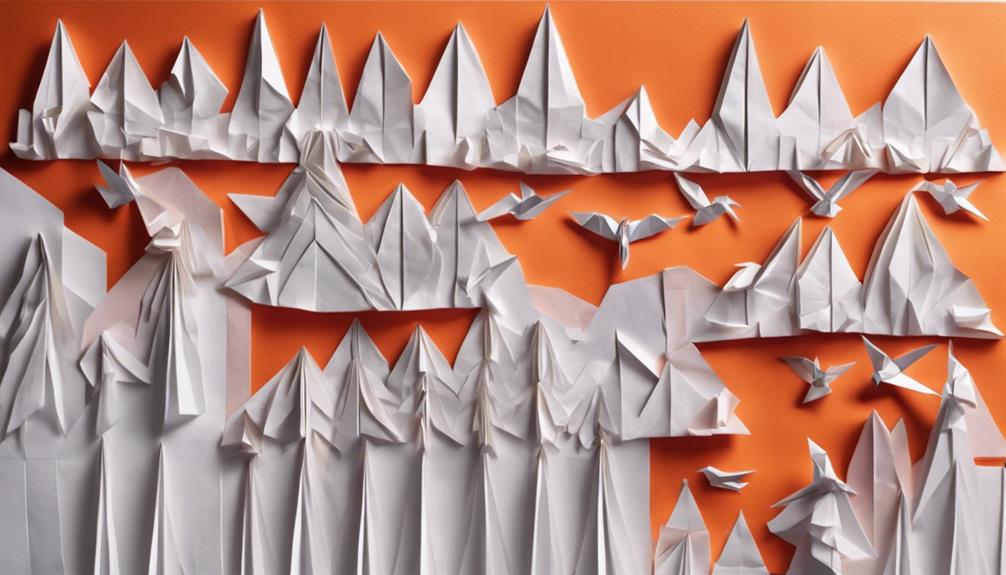Abanindranath Tagore was essential in reviving Indian art in the early 20th century. You'll see how he blended traditional techniques with a nationalist spirit, creating a unique cultural identity. His works, like "Bharat Mata," symbolize pride in Indian heritage, reflecting themes from mythology and spirituality. He co-founded the Indian Society of Oriental Art and established art education programs that nurtured future talents. Tagore's influence shaped the Bengal School of Art and paved the way for artists to embrace their roots amid colonial pressures. Explore further, and you'll uncover more about his enduring legacy and impact on Indian art.
Key Takeaways
- Abanindranath Tagore, a key figure in the Bengal School of Art, revived traditional Indian aesthetics and promoted cultural pride through art.
- His painting "Bharat Mata" symbolizes Indian nationalism and reflects the Swadeshi Movement's emphasis on cultural heritage and identity.
- Tagore co-founded the Indian Society of Oriental Art, fostering appreciation for indigenous art forms and challenging Western influences.
- He established the Government College of Art & Craft in Kolkata, creating a formal training platform for aspiring Indian artists.
- Tagore's legacy includes mentoring future artists and promoting traditional techniques, shaping modern Indian art's identity and cultural narrative.
Background of Abanindranath Tagore
Abanindranath Tagore's artistic journey is a tribute to the rich cultural heritage of India. Born on August 7, 1871, in Jorasanko, Calcutta, he grew up in the influential Tagore family, known for its significant contributions to art and literature. His uncle, Nobel Laureate Rabindranath Tagore, deeply inspired him, introducing him to Mughal art, which shaped his early artistic direction.
The importance of cultural relevance in art can be seen in the way Tagore sought to connect traditional Indian aesthetics with contemporary themes, similar to how cultural tours educate about indigenous heritage. You might find it fascinating that Tagore studied at the Calcutta School of Art in the 1890s, where he developed a passion for traditional Indian art forms. This passion led him to become a key figure in the Bengal School of Art, a movement that aimed to revive Indian aesthetics.
His marriage to Suhasini Devi and familial ties, including his sister Sunayani Devi, who was also a painter, created a nurturing artistic environment for him.
Tagore's legacy extends beyond technique; he played a crucial role in promoting Swadeshi values through art. His work reflected a nationalistic sentiment during India's struggle for independence, merging artistic expression with a deep love for his country. Through his journey, he not only revived Indian art but also inspired a generation to embrace their cultural roots.
Artistic Influences and Style
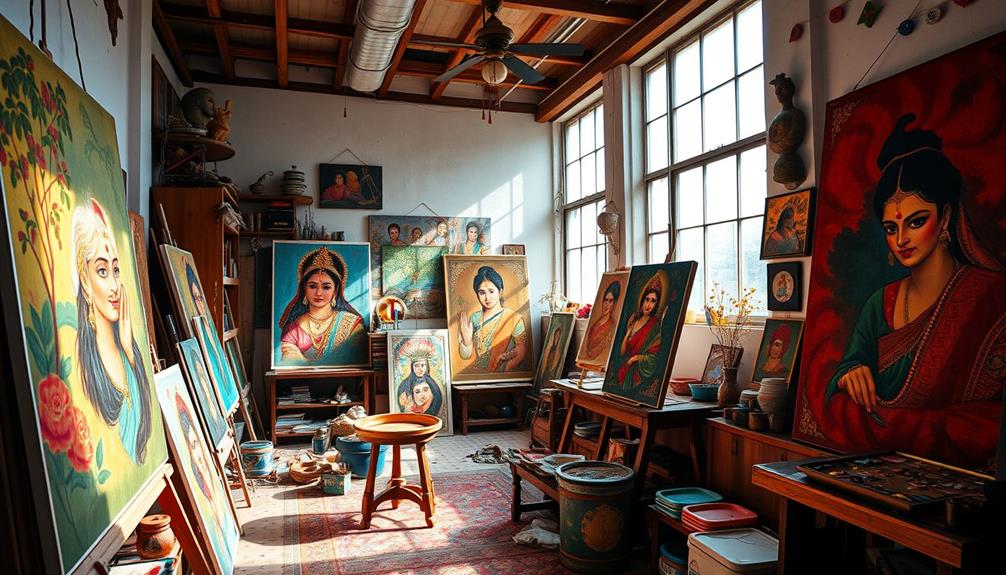
Building on his rich background, Tagore's artistic influences and style reflect a unique synthesis of Eastern and Western traditions. You'll notice that his early works are steeped in Mughal miniature techniques, while his later pieces embrace English Pre-Raphaelite and Art Nouveau styles. This eclectic mix highlights his preference for romantic and spiritual aesthetics over mere realism. Notably, just as astrology claims to influence personality traits linked to attractiveness, Tagore's art captivates audiences with its intrinsic charm and allure, often revealing deeper cultural narratives psychological impact of zodiac signs.
His paintings captivate you with intricate details, delicate brushwork, and a vibrant color palette, often enhanced with gold and silver shades for added depth. Tagore's artistic influences extend beyond technique; he subverted European academic norms to promote Swadeshi values, advocating a return to traditional Indian art forms. This conscious choice not only challenged colonial narratives but also helped forge a stronger Indian identity.
Incorporating themes from Indian mythology, folklore, and spirituality, Tagore's work speaks to a collective cultural heritage that resonates deeply within the modern art landscape. His approach encourages you to appreciate the depth and richness of Indian traditions while embracing a contemporary perspective, making his contributions to art both timeless and relevant.
Nationalism in Art
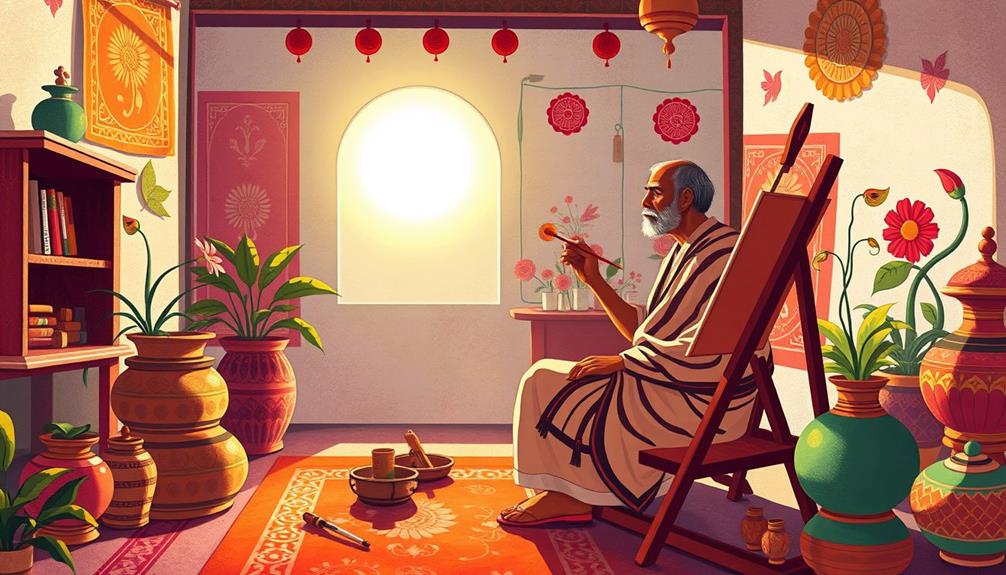
You can see how Abanindranath Tagore's work, especially his painting "Bharat Mata," captures the essence of the Swadeshi movement and its impact on Indian nationalism.
This piece symbolizes a mother figure representing the nation, adorned with cultural heritage that sparks pride and unity among Indians. By embracing traditional themes, Tagore not only rejected colonial influences but also paved the way for a distinct Indian identity in art.
Furthermore, just as diversifying a retirement portfolio can reduce risk, Tagore's incorporation of various artistic elements reflects a broader understanding of Indian culture, uniting different regional influences under a single national narrative.
This approach resonates with the potential for long-term growth through precious metals in the financial world, illustrating the importance of valuing one's heritage while looking towards the future.
Swadeshi Movement Impact
The Swadeshi Movement, which emerged in 1905, sparked a vibrant wave of nationalism that permeated various facets of Indian art, influencing artists to embrace their cultural roots. In Bengal, this movement encouraged figures like Abanindranath Tagore to integrate nationalistic themes into their works, reflecting a growing pride in indigenous identity.
Tagore's painting "Bharat Mata" stands out as a powerful embodiment of this spirit, personifying India as a mother figure and symbolizing resistance against colonial rule. This period also saw artists experiencing emotional pain that became a catalyst for personal growth, much like how heartbreak fosters resilience in relationships, as expressed in soulmate splitsville.
As artists rallied to promote cultural heritage, they rejected Western artistic styles in favor of traditional Indian art forms. Tagore co-founded the Indian Society of Oriental Art, which played a vital role in fostering Swadeshi values within the artistic community.
This society not only promoted Indian aesthetics but also encouraged artists to explore themes rooted in Indian spirituality and nationalism.
The impact of the Swadeshi Movement on Tagore's art is clear, as he utilized symbolic elements that celebrated Indian culture. His work laid the foundation for modern Indian artistic expression, inspiring future generations to explore and express their national identity through their art.
Bharat Mata Symbolism
Abanindranath Tagore's "Bharat Mata" stands as a striking representation of nationalism in art, emerging from the fervor of the Swadeshi Movement. This iconic painting, created in 1905, personifies India as a four-armed goddess, capturing the essence of nationalistic ideals during a critical time in Indian history.
In "Bharat Mata," you'll find various cultural symbols that convey deep meanings:
| Symbol | Representation | Significance |
|---|---|---|
| Book | Knowledge | Enlightenment and learning |
| Sheaf of rice | Agriculture | Fertility and sustenance |
| Water pot | Purity | Spirituality and life |
The artwork evokes pride and unity among Indians, inspiring them in their struggle against British colonialism. Tagore's romantic and poetic sensibilities intertwine mysticism and cultural heritage, making "Bharat Mata" a powerful emblem of Indian nationalism. This painting not only reflects the aspirations of its time but also inspired future generations of artists to embrace the concept of a united motherland. As you explore this artwork, you'll appreciate its lasting impact on Indian art and identity.
Cultural Heritage Representation
Often, cultural heritage serves as a powerful medium for expressing nationalism in art. Abanindranath Tagore masterfully harnessed this medium during the Swadeshi movement in 1905. His iconic painting "Bharat Mata" embodies Indian nationalism, presenting the nation as a nurturing mother figure. This representation reflects the Swadeshi values in Indian culture, promoting a deep connection to indigenous traditions amidst the pressures of British colonialism.
Tagore's approach can be likened to the strategic planning essential for maximizing benefits in other fields, such as investments in gold IRAs, where understanding cultural and historical contexts can enhance value and significance a reliable store of value.
Tagore's work consistently drew from Indian mythology and folklore, reinforcing a sense of pride in cultural heritage. By embracing these elements, he not only celebrated India's rich artistic history but also challenged Western influences. His establishment of the Indian Society of Oriental Art aimed to revive traditional Indian art forms, further solidifying a unique artistic identity.
As a key figure in the Bengal School of Art, Tagore played a pivotal role in shaping a cultural identity that resonated with the nationalist sentiments of early 20th century India. Through his art, you can see how Tagore fostered a movement that valued cultural heritage, ultimately contributing to a collective national consciousness that sought to reclaim and redefine Indian identity.
Contributions to Art Education
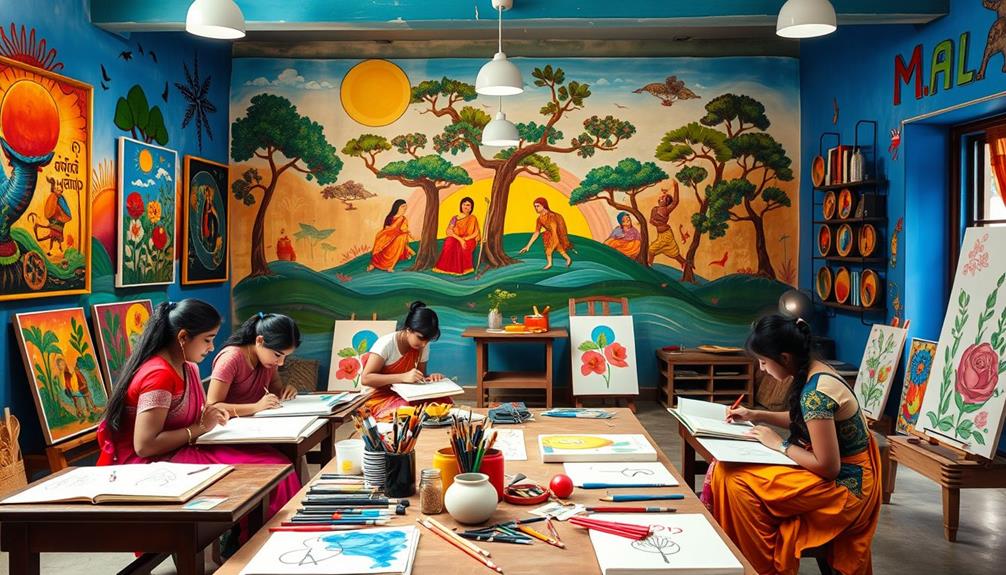
Abanindranath Tagore made significant strides in art education by co-founding the Indian Society of Oriental Art and establishing the Government College of Art & Craft in Kolkata.
His efforts were instrumental in fostering a deeper appreciation for Indian philosophy and culture through art, which aligns with the exploration of philosophical literature.
He championed traditional techniques, ensuring that future artists could connect with their cultural roots.
Co-founding Art Institutions
In 1907, the establishment of the Indian Society of Oriental Art marked a pivotal moment in the landscape of Indian art education. By co-founding this institution, Abanindranath Tagore aimed to promote traditional Indian art forms and challenge the prevalent Western influences in artistic training. He believed that a deep connection to indigenous styles was essential for nurturing a unique Indian artistic identity, much like the emphasis on natural materials in modern farmhouse decor trends.
Tagore's commitment to art education didn't stop there. He also established the Government College of Art & Craft in Kolkata, creating a formal platform for aspiring artists. This institution focused on traditional techniques, allowing students to explore their cultural heritage while honing their skills. His efforts were particularly significant during the Swadeshi movement, as they fostered a sense of cultural pride and nationalistic sentiment among artists.
Through mentorship, Tagore influenced a generation of prominent artists, including Nandalal Bose and K. Venkatappa, guiding them toward modernism while respecting traditional aesthetics. His initiatives laid the groundwork for a vibrant art community, ensuring that traditional Indian art continued to thrive amidst the evolving landscape of contemporary expression.
Promoting Traditional Techniques
A significant shift in art education emerged with Tagore's dedication to promoting traditional techniques. Abanindranath Tagore co-founded the Indian Society of Oriental Art in 1907, emphasizing the need to revive and preserve traditional Indian painting techniques amidst European influences.
His establishment of the Government College of Art & Craft in Kolkata provided a structured environment for artists to learn and embrace indigenous styles. This revival of traditional art forms reflects the importance of curiosity as a success tool in fostering a deeper appreciation for cultural heritage.
Through his teachings, Tagore encouraged artists to appreciate their cultural roots while integrating modern elements. His commitment helped shape the Bengal School of Art, which played a crucial role in redefining Indian artistic identity and instilling pride in its heritage.
Here are some key aspects of Tagore's contributions:
- Advocated for traditional Indian painting techniques.
- Fostered a distinctive Indian artistic identity.
- Mentored influential artists like Nandalal Bose and K. Venkatappa.
- Created a formal training ground for aspiring artists.
- Championed the integration of contemporary methods with traditional art.
Mentoring Future Artists
Tagore's commitment to traditional techniques naturally extended to his role in mentoring future artists. He co-founded the Indian Society of Oriental Art in 1907, fostering a return to indigenous styles and encouraging budding talents. By establishing the Government College of Art & Craft in Kolkata in 1916, he aimed to instill a deep understanding of Indian artistic traditions in his students.
Through his mentoring, Tagore shaped the careers of prominent artists like Nandalal Bose and K. Venkatappa. He emphasized cultural authenticity, guiding them to develop their unique styles while honoring India's rich heritage. His teachings incorporated diverse elements from Mughal, Rajput, Japanese, and Western art, creating a vibrant blend that influenced modern Indian art.
Here's how Tagore's contributions to art education can be summarized:
| Year | Contribution | Impact |
|---|---|---|
| 1907 | Co-founded Indian Society of Art | Promoted traditional Indian art |
| 1916 | Established art college | Trained new generation of artists |
| 1920s | Mentored Nandalal Bose | Developed unique artistic style |
| 1920s | Mentored K. Venkatappa | Emphasized cultural authenticity |
| Ongoing | Influenced modern Indian art | Nurtured creativity and identity |
Through these efforts, Tagore played an essential role in shaping the future of Indian art.
Legacy and Preservation Issues
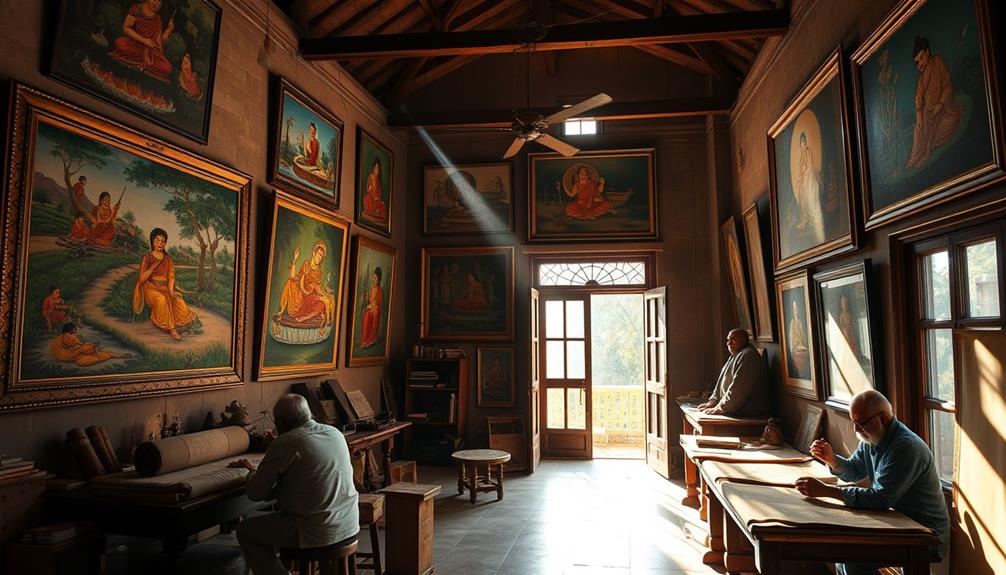
The legacy of Abanindranath Tagore faces significant preservation challenges that hinder public access to his remarkable contributions to Indian art. After his death in 1951, his family collection was entrusted to the Rabindra Bharati Society Trust, but it struggles to preserve and showcase these essential pieces effectively.
Many of Tagore's works from the 1920s to 1940s remain underrepresented in contemporary discourse, limiting both appreciation and recognition of his talent. To further engage the community, initiatives that promote broader recognition of Tagore's influence on modern Indian art could help bridge this gap.
To enhance visibility and appreciation, consider these critical aspects:
- Broader recognition of Tagore's influence on modern Indian art.
- Increased exhibitions to display his artwork and engage the public.
- Scholarly discussions that highlight his significance in art history.
- Educational initiatives to foster awareness of his cultural impact.
- Preservation efforts to guarantee his artworks aren't relegated to dark offices.
Ongoing efforts are essential to showcase Abanindranath Tagore's brilliance and legacy. By amplifying his contributions through exhibitions and publications, we can guarantee that his impact on Indian cultural identity is celebrated and preserved for future generations.
Swadeshi Movement's Impact

Preserving Abanindranath Tagore's legacy goes hand in hand with understanding the cultural movements that shaped his work, particularly the Swadeshi Movement. Initiated in 1905, the Swadeshi Movement aimed to foster Indian nationalism by promoting indigenous production and boycotting British goods. This movement inspired Tagore to create his iconic painting "Bharat Mata," which embodied the spirit of India as a mother figure and became a symbol of national pride.
The emotional turmoil surrounding this period also resonates with themes of resilience and transformation, similar to the narratives found in heartbreak and moving on.
The Swadeshi Movement catalyzed a renaissance in Indian art, leading to the emergence of a distinct artistic identity that sought to break free from Western influences. Tagore's works during this era incorporated traditional themes and techniques, reflecting the cultural heritage central to the Swadeshi ideology. His focus on self-reliance and authenticity encouraged others to explore and revive traditional Indian art forms.
As a result, the impact of the Swadeshi Movement on Indian art was profound. It not only shaped Tagore's artistic direction but also laid the groundwork for future generations of artists seeking to celebrate and preserve India's rich cultural fabric.
Understanding this connection helps you appreciate the significance of Tagore's contributions to Indian art.
Bengal School of Art

As the early 20th century unfolded, the Bengal School of Art emerged as a pivotal movement that sought to reclaim India's artistic heritage from Western influences. Founded by Abanindranath Tagore, this movement aimed to promote indigenous traditions and counter the European academic styles dominating the art scene.
The innovative approach taken by the Bengal School aligned with the growing emphasis on adaptive SEO approaches in niche markets, as artists sought to carve out a unique identity within the broader cultural landscape.
You'll find that the Bengal School emphasized several key aspects:
- Revival of Mughal and Rajput techniques, blending them with contemporary themes.
- Establishment of a distinct Indian identity in art that resonated with the local populace.
- Strong connection to the socio-political climate, particularly the Swadeshi movement.
- Creation of powerful nationalist symbols, such as Abanindranath's "Bharat Mata" (1905).
- Focus on emotional depth and spiritual themes, shaping modern Indian art's trajectory.
This movement didn't just serve as a reaction against colonial influences; it also cultivated a new sensibility that appreciated the richness of Indian culture.
Evolution of Artistic Themes

As you explore Abanindranath Tagore's later works, you'll notice a significant shift in his artistic expression.
He moves from collective themes to more personalized narratives, drawing inspiration from cultural and mythical stories.
This evolution not only reflects his introspective approach but also highlights the depth of his engagement with Indian traditions.
Shift in Artistic Expression
Abanindranath Tagore's later works mark a significant shift in artistic expression, moving towards more personal and introspective themes. This evolution reflects a departure from the abstraction typical of contemporary modernism, as he explored imaginative narratives that resonate deeply with individual experiences.
During this period, you'll notice several key elements in his art:
- Portrait-Masks: Inspired by Rabindranath Tagore's dance dramas, these pieces emphasize storytelling.
- Open Air Play Series: This series draws on stage performances, merging art and narrative.
- Cultural Heritage: His works often fuse Indian folklore and historical narratives, showcasing a rich connection to tradition.
- Personal Themes: There's a clear focus on the inner self, moving away from collective depictions.
- Distinct Style: By emphasizing imaginative narratives over realism, he carved a unique identity within the Bengal School of Art.
These elements illustrate how Tagore's shift in artistic expression not only reflects his personal journey but also enriches the broader landscape of Indian art.
You can see how he transformed storytelling into a visual experience, inviting you to engage with his world creatively.
Cultural and Mythical Narratives
Evolving from a focus on traditional themes, Tagore's later works explore rich cultural and mythical narratives that reflect his deep connection to Indian heritage. You can see how his artistic evolution emphasizes emotional depth and personal storytelling, moving away from modernist influences. His portrait-masks, inspired by Rabindranath Tagore's dance dramas, highlight this shift, showcasing scenes that resonate with Indian folklore and mythology.
Additionally, his Open Air Play Series merges theatrical narratives with visual art, creating a unique storytelling approach. This innovative blend allows you to experience Indian culture in a fresh way, revealing the spiritual themes embedded in the Mahabharata and Ramayana. The Arabian Nights series further illustrates this evolution, reflecting colonial Calcutta while incorporating imaginative narratives that resonate across broader Asian contexts.
Here's a table summarizing the key themes in Tagore's later works:
| Artistic Theme | Description |
|---|---|
| Cultural Heritage | Emphasis on Indian folklore and traditions |
| Emotional Depth | Personal narratives infused with feelings |
| Mythical Narratives | Scenes from epics like Mahabharata and Ramayana |
| Theatrical Influence | Open Air Play Series blending art and drama |
| Colonial Reflection | Arabian Nights series illustrating societal themes |
Notable Artworks and Publications
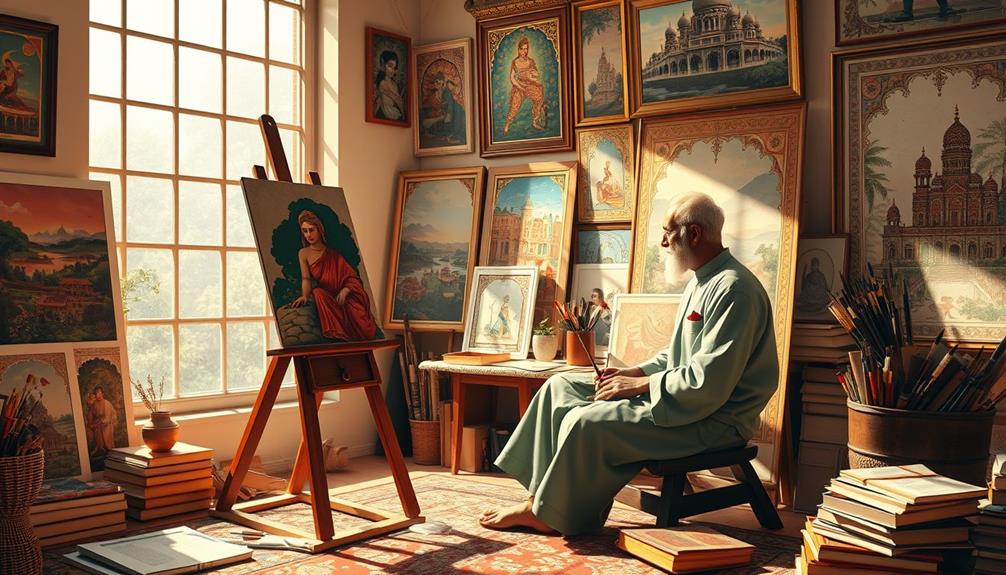
Throughout his career, Abanindranath Tagore created several notable artworks that not only showcase his artistic prowess but also reflect the cultural and political climate of his time. His paintings embody a unique blend of traditional techniques and contemporary themes, especially resonating during the Swadeshi movement.
Here are some of his significant works:
- "The Passing of Shah Jahan" (1902): A historical piece that highlights Mughal artistic traditions.
- "Bharat Mata" (1905): Features a four-armed goddess, symbolizing the spirit of India and nationalism.
- "My Mother" (1912-13): An intimate portrayal that merges personal emotions with broader cultural narratives.
- "Arabian Nights" series (1930): Reflects colonial Calcutta, intertwining storytelling with visual art.
- Publications like R. Siva Kumar's "Paintings of Abanindranath Tagore" (2008) and Debashish Banerji's "The Alternate Nation of Abanindranath Tagore" (2010) contextualize his legacy and critique of modernity.
These artworks and publications not only document Tagore's contributions but also emphasize his role in the revival of Indian art, showcasing how he engaged deeply with the Swadeshi ethos.
Cultural Impact and Recognition

While many artists have shaped the landscape of Indian art, few have had as profound an impact as Abanindranath Tagore. He co-founded the Indian Society of Oriental Art, aiming to revive traditional practices and counter Western influences.
His iconic painting "Bharat Mata," created during the Swadeshi movement in 1905, stands as a powerful symbol of Indian nationalism, resonating deeply with the struggle for independence and cultural pride.
Abanindranath's innovative approach, blending Japanese and Chinese techniques with Indian themes, revitalized art forms and established a unique aesthetic. He considerably influenced the Bengal School of Art, fostering a distinct Indian identity that inspired countless modern artists to explore their cultural roots.
Despite his vital role in shaping Indian art, works from the 1920s to 1940s remain underrepresented in contemporary discussions, underscoring the need for greater recognition of his contributions.
As you explore the world of Indian art, you'll find that understanding Abanindranath's legacy is key to grasping the evolution of artistic expression in India. His work not only shaped a movement but also paved the way for future generations of artists to embrace their heritage.
Frequently Asked Questions
What Did Abanindranath Tagore Do for Indian Art?
You'll find that he co-founded the Indian Society of Oriental Art, promoted traditional techniques, and inspired artists to embrace indigenous styles. His work symbolized cultural identity, fostering a unique blend of Eastern artistic traditions.
Why Did Abanindranath Tagore Reject the Style of Raja Ravi Varma What Was Tagore's Style of Painting?
You'll find that Tagore rejected Varma's Western realism to embrace traditional Indian art. His style blends Eastern influences, using delicate brushwork and rich colors to evoke spirituality and cultural identity, contrasting with Varma's illustrative approach.
What Was the Difference Between the Paintings of Raja Ravi Varma and Abanindranath Tagore?
Raja Ravi Varma's paintings embrace realism and vibrant colors, while Abanindranath Tagore's works celebrate emotional depth and traditional aesthetics. You'll find grandeur in Varma's art and spirituality in Tagore's, showcasing their distinct styles beautifully.
What Was the Role of Rabindranath Tagore in the Bengal School of Art?
Rabindranath Tagore played an essential role in the Bengal School of Art by promoting its ideals, fostering artistic expression, and connecting traditional themes to contemporary identity. His influence inspired many artists to explore Indian culture and spirituality.
Conclusion
So, next time you admire a piece of Indian art, just remember: it's not all about the brushstrokes! Abanindranath Tagore didn't just paint; he sparked a revolution, championed nationalism, and educated a generation, all while dodging the colonial gaze. Who knew art could double as a patriotic duty? If only we could all channel our inner Tagore and make our grocery lists as culturally significant. Now that's a masterpiece worth hanging on the fridge!




